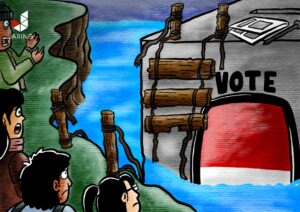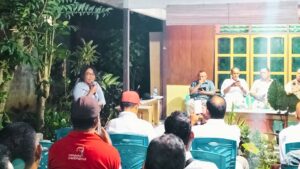In the last five years, Jopi Hendrayani (48) has never reaped any profits from the dried tobacco he sells. The 4-quintal tobacco he harvested from a 50-are farmland in Beleka village, Praya Timur, Central Lombok Regency, was only priced at Rp 13 million, lower than the planting costs of Rp 16 million.
“Almost every year, we experience losses. Even if it can only reach a break-even, it would be good enough,” Jopi told Jaring.id in a phone interview on Monday, December 7, 2020.
Jopi is not the only self-subsistent farmer who depends on tobacco for life. There are at least 4.000 farmers in Central Lombok facing the same problem. In the book of Tobacco 2018- 2020 released by the Ministry of Agriculture’s Directorate General of Plantation, West Nusa Tenggara is one of Indonesia’s centers for tobacco production. Last year, the province produced 46.077 tons, or increased 11.259 tons compared to the production level of 2018.
The increase of production in the province is not in line with the quantity of tobacco purchased by the industry, which is only 26.000 tons, or equivalent to 26 billion sticks. Director of Seasonal Crops and Spices at the Ministry of Agriculture, Hendratmojo Bagus, agreed about this gloomy condition, saying that farmers often complain about the selling price of tobacco.
“The price (of tobacco) remains an unfinished work. Is it because the quality does not match with the needs of the industry or are there indications related to the marketing chain?” Hendratmojo queried when contacted by Jaring.id on Thursday, December 17, 2020.
***
Prayanto, one of the farmers partnering with PT Djarum in Wanungan Gunung Village, Temanggung, East Java, said that the price of tobacco purchased by the industry was highly determined by the company’s assessment. Kemloko tobacco produced by Yanto, for example, can be valued up to Rp 150.000 per kilogram if it is included in grade F. However, if the quality is not so good, the price can drop to Rp 30.000 per kilogram for grade A.
The grade is determined by graders, who are in charge of assessing the quality of tobacco. They will decide whether the farmers’ tobacco will be purchased by the company or not.
“Graders are usually old workers at the company. It has been a hereditary relationship. They determine the grade and also set the price,” he said when contacted by Jaring.id on Tuesday, December 15, 2020.
There are several standards to assess the quality of tobacco, particularly the aroma and the color of tobacco, and that one type of tobacco should not be mixed with others. Even though they are listed as the partnering farmers, the tobacco that does not pass the assessment will not be purchased by the company.
In fact, the company has set some various requirements to enable tobacco farmers being registered as partnering farmers, such as owning a land with ownership rights, minimum area of 0.3 hectares, committing to not mix the tobacco plants controlled by the company with local plants, and following all guidelines carried out by the industry.
“Until harvest time, the color of the tobacco should meet the company’s requirements,” he said.
Last year, the tobacco that Yanto planted was considered not of prime quality. As a result, the increase in production did not make him earn bigger profits. In addition, companies often use the price of cigarettes as an excuse to determine the purchase price of tobacco. However, based on his experience, the price of tobacco has not increased even though the price of cigarettes has continued to soar.
Indeed, farmers have a weak bargaining position. This has also been experienced by Jopi. Since becoming a tobacco farmer in 2009, he has never been able to sell his crops directly to the company.
“We have to go through the middlemen,” Jopi said.
According to Jopi, the first leaves of virginia tobacco were valued at Rp 800.000 per kilogram by the middlemen, far below the price estimated by the warehouse of the company, which reaches Rp 1,8 million per kilogram.
“The middlemen have a special card to enter the warehouse. They can reap double profits,” he said.
The condition where there is a pressure against tobacco farmers by the middlemen is exacerbated by the limitation of tobacco quota that would be purchased by the company. Until now, Jopi and thousands of other tobacco farmers are not sure about the basis to determine the quota.
Only middlemen and the partnering farmers know the quota of each warehouse, he said.
“They always give the same cliche excuses, saying the quota is full.”
The partnering farmers meant by Jopi are the farmers fostered by the cigarette industry, enabling them to produce tobacco in accordance with the industrial needs. In Central Lombok, there are 50 farmers who become the partners of Djarum dan Gudang Garam.
***
A 2020 research by University of Indonesia’s Center for Social Security Research (PKJS), mentions that tobacco farmers are still trapped in an oligopsonistic trading system or a market that only consists of a handful of buyers. The research conducted in Central Lombok, Pamekasan, and Kendal found that farmers do not have the bargaining power to determine the quality and price of the tobacco they produced.
“Farmers are less empowered in the tobacco trade system. They tend to surrender to the price set by the warehouse management or the middleman because they are worried that their tobacco will not be purchased,” PKJS UI researcher Suci Puspita Ratih told Jaring.id, Tuesday, December 15, 2020.
In addition, according to Suci, the quantity of tobacco purchased by companies from farmers is uncertain. However, the companies often set the quota of tobacco lower than the quantity produced by farmers. She mentioned that switching crops to commodities other than tobacco could be a solution to overproduction.
“Tobacco is not the most profitable commodity for farmers because of its high production cost and the weather factor,” Suci said.
She highlighted another factor, the tobacco excise revenue sharing (DBH CHT), which is not optimal. According to her, the revenue sharing scheme which is based on the increase in excise, has not been able to help improve the welfare of farmers.
“Most of the fund on this scheme is allocated for the health sector. This remains controversial,” she added.
In relation to this issue, the government recently issued the Minister of Finance Regulation number 198 / PMK.010 / 2020. This regulation stipulates that the excise tax on tobacco products increased by 12,5 percent by February 1, 2021.
The excise will increase by 18.4 percent for machine-made white cigarette (SPM) Group I and 18,5 percent for SPM Group IIB. For machine-made kretek (SKM) Group I, the excise will increase by 16,9 percent. SKM Group IIA and SKM Group IIB will see a raise of excise as much as 13,8 percent and 15,4 percent, respectively.
“For the cigarette industry producing hand-rolled kretek (SKT), the excise tariff does not change,” said Minister of Finance Sri Mulyani during a press statement on Thursday, December 10, 2020.
Although the tax increase scheme has not yet touched the retail sales price (HJE), Sri Mulyani hopes that this decision can reduce the prevalence of smokers, in accordance with the 2020-2024 National Medium-Term Development Plan (RPJMN).
“The increase of excise on tobacco products will cause cigarettes to be more expensive. The affordability index will increase to 12,2%, 13,7%, up to 14%, so that they are increasingly unaffordable,” she added.
Sri said the government would also focus on using 50 percent of the revenue sharing excise fund to improve the welfare of farmers and workers in the tobacco products industry. One way is to improve the quality of raw materials and diversify crops for tobacco farmers.
***
In relation to the excise hike and the welfare of tobacco farmers, Jopi has a personal experience. During multiple times of excise increase, tobacco farmers are often being pushed to decrease their selling price.
For instance, when the excise rose by 10,04 percent in 2018, the price of tobacco he sold was not more than Rp 60.000.
“The excise hike is being used to oppress the farmers to give a lower price,” he said.
He also argued that tobacco import is the main reason behind the dropped tobacco price.
“It is because of the import. That is why the warehouse is full.”
Director of the Beverage Industry, Tobacco Products and Refreshments at the Ministry of Industry (Kemenperin) Edy Sutopo said the quality of domestic tobacco had not been able to meet industrial needs. In 2017, tobacco imports were recorded at 119.545 tonnes, and increased to 121.390 tonnes in 2018, but decreased to 110.923 tonnes in the following year. According to Edy, the average annual import requirement ranges between 100 to 130 thousand tons.
“Some variants of the imported tobacco have been produced domestically, including virginia tobacco. Perhaps, we need to think it over. If we are able to produce some of the tobacco domestically, then we should adjust the import quota,” he said in an interview on December 17, 2020.
In response to this, a member of the People’s Representative Council (DPR) Viva Yoya Mauladi agreed with import limitation. He claimed that the absence of an import quota would actually decrease the tobacco price for the farmers.
“Farmers are always at loss and become the object to comply with the manufacturers’ interests. This determines the price of the tobacco they would purchase from the farmers. Thus, the price is not determined based on the balance between supply and demand,” said Viva Yoya Mauladi when contacted by Jaring.id on Thursday, December 17, 2020.
Director of Human Resources at the University of Indonesia (UI), Abdillah Ahsan, said the government needed to strictly control tobacco imports. One of them is by increasing import duty tariff by up to 15 percent. That way, the production of local tobacco can expectedly be optimized.
“It is better to double the tariff. If the import prices are raised, companies will then buy tobacco from farmers,” he said in an interview on Thursday, October 17, 2020.
On the other hand, Chairman of the Association of Indonesian White Cigarette Producers (Gaprindo) Muhaimin Moefthi did not agree with a quota or an increase in excise rates. Until now, local tobacco production has not been able to meet the needs of the industry.
“Generally, the demand for tobacco from manufacturers is 300 thousand tons a year, while the production is 200 thousand tons at most. Whether we like it or not, we have to import tobacco,” he said when contacted on Friday, December 18, 2020.
To ensure that the tobacco produced by farmers will be purchased by cigarette manufacturers, Moefthi suggested that the limitations should be directed to non-tariff regulations. For example, when a cigarette company imports 1 tonne of tobacco, they are obliged to purchase 2 tonnes from the farmers. This scheme is currently being discussed between the industry and the government. “Traditional sales are indeed carried out through middlemen. Therefore, the government should intensify campaigns to encourage farmers to build partnerships with companies in order to cut the sales chain to industry,” he said.







